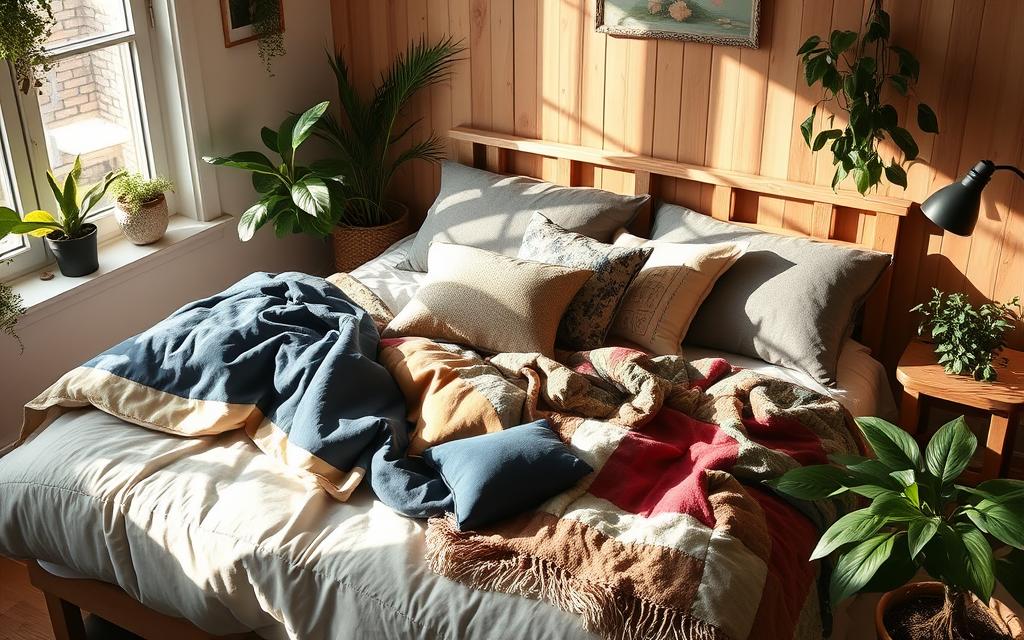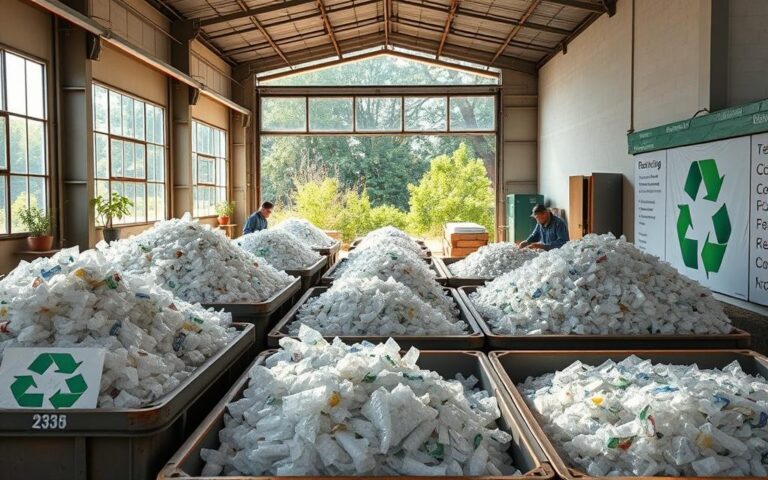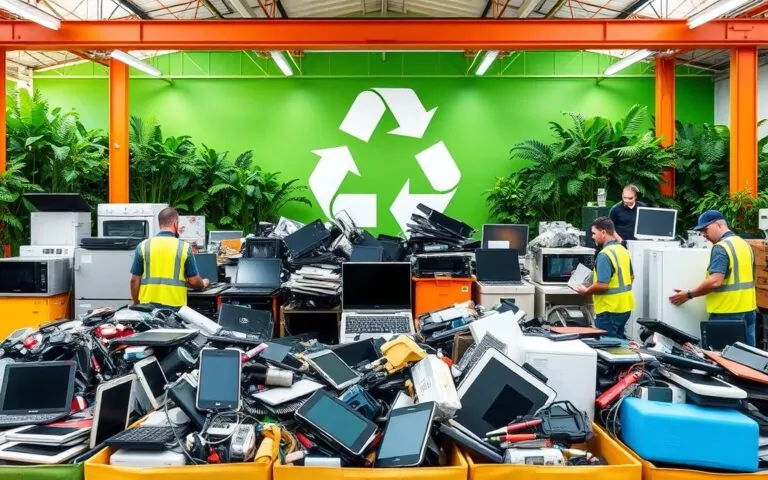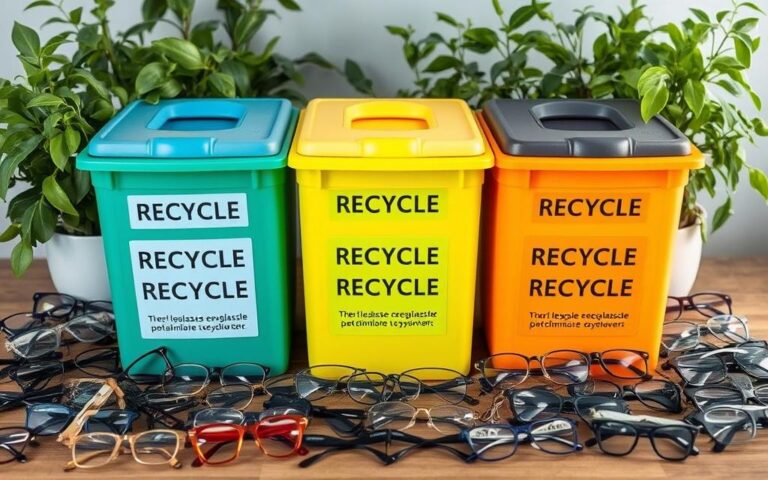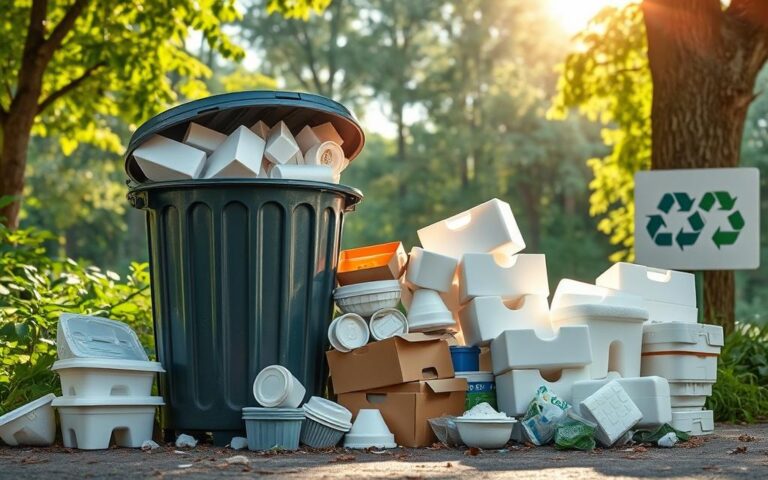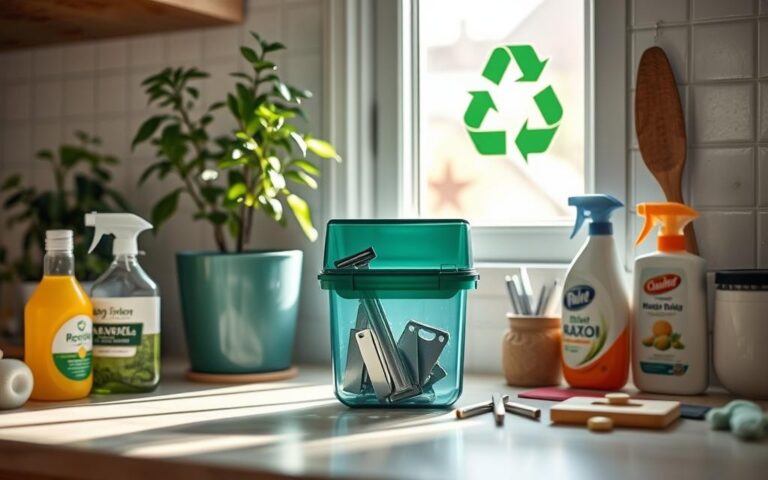Where to Recycle Old Duvets: Sustainable and Responsible Tips
Understanding how to dispose of old duvets responsibly is very important. Each year, the fashion industry produces vast amounts of textile waste. This equals a garbage truck of waste every second. Sadly, only 15% of old duvets find new life in crafts or pet bedding. A big 25% just end up in landfills, mostly because people don’t know better options.
Recycling duvets helps stop waste from harming our planet. It keeps harmful substances out of our ecosystems. Plus, it supports a cycle that’s good for the earth’s future. In fact, in the UK, about 60% of old duvets are recycled through council services or special centres. This shows how making the right choices can lead to more eco-friendly bedding solutions.
Understanding the Importance of Recycling Bedding
Recycling bedding plays a vital role in tackling the textile waste crisis. In the UK, there’s a huge issue with about 300,000 tonnes of textile waste yearly. A big part of this waste comes from old duvets and pillows. These end up mostly in landfills, posing a threat to our environment.
When in landfills, about 85% of these items release harmful chemicals. Such chemicals from synthetic materials can pollute our soil and water.
The Environmental Impact of Textile Waste
Textile production significantly contributes to the world’s carbon emissions, making up 10% of the total. The damage this waste causes to our planet is alarming. The issue worsens with synthetic duvets. They can take hundreds of years to break down, increasing pollution and landfill strain.
However, there’s a positive note. Natural bedding, like wool duvets with organic cotton covers, can decompose in just three months. These help enrich our soil instead of hurting it.
Why Duvets and Pillows Are Problematic for Landfills
Duvets and pillows aren’t just bulky. Their synthetic makeup makes them difficult to break down. Yet, recycling offers a solution to these challenges.
Initiatives like the Dunelm Textile Take Back Scheme and H&M Garment Collecting Programme show recycling’s impact. By recycling, we can drastically cut down waste. Donations to charities or shelters are another green solution. It aids those in need while caring for our planet.
These efforts reduce waste and encourage community social responsibility.
Where to Recycle Old Duvets
It’s vital to find local places to recycle old duvets to cut down on textile waste. You should look at various options, like local councils and bigger recycling schemes. This makes sure your old bedding is gotten rid of in a good and green way.
Contacting Local Councils and Recycling Centres
Start by chatting with your local council as they often recycle textiles, including duvets and pillows. Services differ by area, so checking what your local area offers is key. Remember these tips:
- Learn about your council’s policy on recycling fabrics.
- See if there are specific spots to drop off bedding or if they collect it.
- Some councils work with charities to help recycle items.
Finding Nationwide Recycling Initiatives
If local options aren’t available, look into nationwide recycling projects. Sites like Recycle Now and London Recycles help you find recycling points for bedding. They list places that take part and let you see your options based on where you live. Keep these in mind:
- Places that take natural materials like cotton are common.
- Synthetics might be turned into things like cushions or toys.
- Using these platforms promotes recycling in the right way.
By using local services and wider projects, you make sure your old duvets are recycled properly. This helps our planet a lot.
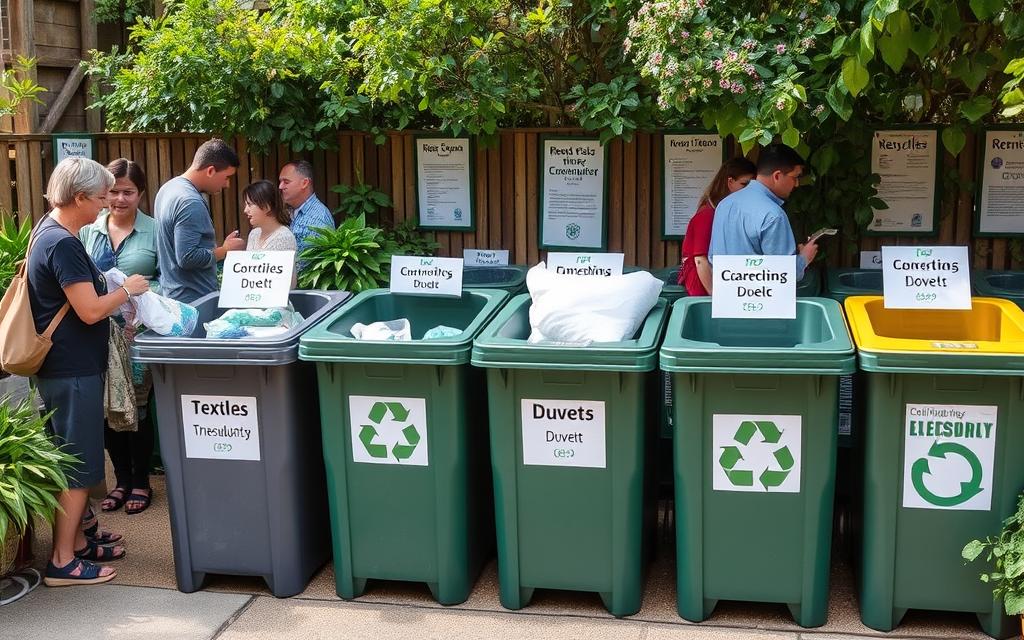
Donating Your Old Duvets and Pillows
Donating your old bedding can help those in need and the environment. Many charities take duvets and pillows, helping people and animals stay warm. It’s important to find the right place to donate to keep items out of landfills.
Organisations That Accept Donations
There are many places where you can donate bedding. Here are a few:
- The Salvation Army – They are happy to receive bedding donations.
- RSPCA – They need old pillows for animal shelters.
- Homeless.org – They accept bedding for homeless people.
- American Textile Recycling Service (ATRS) – They have bins for recycling old bedding.
Guidelines for Donating Used Bedding
There are a few things to remember when donating bedding. Here are some tips:
- Wash items thoroughly – Clean items are preferred by charities.
- Inspect condition – Items should be in good shape for donation.
- Inquire about specific needs – Check if shelters have special rules.
- Research local organisations – Not all charities accept bedding. It’s good to check first.
Donating bedding the right way helps others and the planet. For tips on recycling pillows, visit this resource. Learning how to donate effectively lets you support your community and cut down on waste.
| Charity Name | Type of Donation Accepted | Condition Requirements | Contact Method |
|---|---|---|---|
| The Salvation Army | Pillows, duvets | Clean, gently used | Visit website or call |
| RSPCA | Pillows for animal bedding | In good condition | Check local shelter |
| Homeless.org | Duvets, gently used pillows | Clean and undamaged | Online enquiry form |
| American Textile Recycling Service (ATRS) | Bedding, textiles | Common household items accepted | Locate drop-off bin |
Creative Ways to Repurpose Old Duvets
Old duvets often don’t last long. Instead of throwing them away, think about repurposing them. You can turn these bedding items into something useful and reduce textile waste. Making pet bedding from old duvets is great for your pets and helps local animal shelters too.
Turning Duvets into Pet Bedding
Old duvets can become warm and comfy pet bedding. Shelters, such as the SPCA, are always happy to get donations of duvets, sheets, and pillows. Making a pet bed is easy. Just cut the duvet to size, sew or tie the edges, and you’ve made a cosy bed for your pet. This way, duvets don’t go to waste and your pets get a nice place to sleep.
Craft Ideas Using Old Bedding Materials
Using old materials for crafts can spark your creativity. Here are some ideas:
- Turn duvet filling into soft cushions or plush toys.
- Make shopping bags or tote bags from duvet covers for an eco-friendly choice.
- Create blankets or throws for lounging or picnics.
- Use scraps of duvet material to make fun dog toys.
- Sew a rag rug to add colour to your room.
Repurposing duvets encourages crafty, budget-friendly projects and helps declutter your home. The pandemic saw many people cleaning out their homes and donating old bedding to charities. This shows how one person’s waste can be valuable to another.
Creativity has no limits when upcycling old bedding. You can build forts for kids, teach sewing skills, or find lots of other projects. Recycling feathers or down from duvets for compost, or using pillows for comfort on flights, are small ways we can aim for sustainability.
| Craft Idea | Description | Materials Needed |
|---|---|---|
| Pet Bed | Cozy resting place for pets. | Old duvet, thread, scissors. |
| Shopping Bag | Eco-friendly bag for shopping. | Duvet cover, sewing machine, handles. |
| Rag Rug | Colourful mat for floors. | Scraps of duvet, loom or crochet hook. |
| Soft Toys | Cuddly toys for children or pets. | Filling from duvet, fabric, thread. |
| Blanket Fort | Fun play area for kids. | Old duvet or sheets, chairs. |
Conclusion
Switching to eco-friendly ways of getting rid of old duvets can really help our planet. If you recycle your duvets, you stop them from adding to the 14 million duvets that end up in UK landfills each year. You can take clean ones to local recycling centers. Charities and shelters also welcome bedding that’s still in good shape, helping those in need.
Getting creative with your old duvets can also make a difference. You can turn them into things like pet beds or throw pillows. This way, you’re not just throwing them away. You’re using them to make something new and useful. Choosing to upcycle means you’re thinking about how to buy bedding that’s better for the environment in the future.
Let’s see this as a push to make wise choices when it’s time to throw away bedding. Whether you choose to recycle, donate, or upcycle, every little bit helps. These efforts help reduce the harm textile waste does to the environment. They lead us toward a cleaner, more sustainable world.
FAQ
What is the environmental impact of textile waste from duvets and pillows?
Each year, the UK sees about 61,900 tonnes of duvets and pillows thrown away. This adds a lot to our textile waste problem. Landfills get filled up, and because many materials in these items don’t break down, the environment suffers.
How can I recycle my old duvets responsibly?
You can start by checking with your local council for textile recycling facilities. Also, websites like Recycle Now and London Recycles help you find places to recycle your duvets and pillows.
Is it possible to donate my old bedding?
Yes, places like The Salvation Army and RSPCA welcome used bedding donations. Make sure the bedding is clean and in good shape, as many shelters won’t take items that are too worn or damaged.
What guidelines should I follow when donating bedding?
Before donating, wash your duvets and pillows well. Ensure they aren’t too worn or damaged. This helps make sure they’re fit for someone else to use.
Can old duvets be repurposed for other uses?
Indeed! Old duvets can make great bedding for pets in animal shelters. The filling can also be used for things like cushions and toys. Get creative and see what you can make from the fabric.
Are there any eco-friendly ways to dispose of old duvets?
Yes, if your duvet is made of natural materials, you could compost it. Just remember to remove any synthetic parts first. The natural fibres will help add nutrients to your compost.
What should I do if my local recycling facilities don’t accept duvets?
If you can’t find a recycling place for them, look for special collections in your area. Local charities might also accept them or know how you can dispose of them responsibly.

